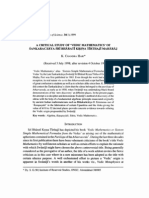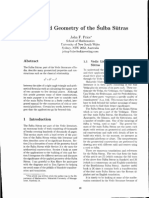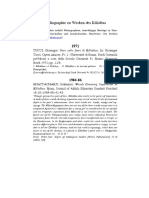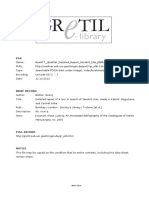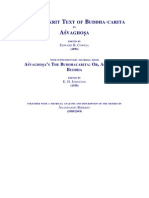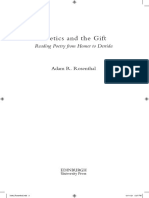Christianity and The Origin of Sanskrit
Christianity and The Origin of Sanskrit
Uploaded by
mahiyagiCopyright:
Available Formats
Christianity and The Origin of Sanskrit
Christianity and The Origin of Sanskrit
Uploaded by
mahiyagiOriginal Description:
Original Title
Copyright
Available Formats
Share this document
Did you find this document useful?
Is this content inappropriate?
Copyright:
Available Formats
Christianity and The Origin of Sanskrit
Christianity and The Origin of Sanskrit
Uploaded by
mahiyagiCopyright:
Available Formats
Presented at the First International Conference on the History of Early Christianity in India New York, August 2005
Christianity and the Origin of Sanskrit
Dr. Alexander Harris appiusforum@alum.MIT.edu
Introduction
In November of 1999, the Pope visited India and media attention was directed to him prior to his arrival. On October 25th, an article appeared in the New Indian Express titled, Tell the Pope how Hindu he is, and it contained a gist of Francois Gautiers forthcoming book, The Indian Origin of Things. In the article it was stated, The Pope is arriving in India on the 5th of November. Does he know that he may be stepping on a land from which Christianity originated? Indeed, over the centuries, numerous historians and sages have pointed out that not only has Hinduism had a predominant influence on Christianity, but that many of the Christian rites could be directly borrowed from Buddhist and Hindu India. French historian Alain Danielou had noticed as early as 1950 that a great number of events which surround the birth of Christ - as it is related in the Gospels - strangely remind us of Buddhists and Krishnaites legends. The article then goes on to state, Great Indian sages, such as Sri Aurobindo or Sri Ravi Shankar, the founder of the Art of Living, which is practiced in more than 80 countries, have often remarked that the stories recounting how Jesus came to India to be initiated, are probably true. Sri Ravi Shankar notes, for instance, that Jesus sometimes wore an orange robe, the Hindu symbol of renunciation in the world, which was not a usual practice in Judaism. Many see the similarities between the two faiths with respect to the Gita, especially in the doctrines of sacrifice, salvation by faith, and total surrender to God and think the Gita was written several hundred years before Christ and probably even Christ might have read the Gita. Masih in his book titled, Shankaras Universal Philosophy of Religion writes about the striking similarity between the lives of Krishna and Jesus, The phenomenon of Krsnajanmastame in which the child Krishna is represented as a suckling at the mothers breast. Nanda, the foster-father of Krishna had gone to Mathura to pay his taxes (just as Joseph had gone to Bethlehem for census). Krishna was born in a cow-shed (Gokula exactly as Jesus was born in a manger); massacre of infants of Mathura by Kamsa (just as the massacre of infants by Herod); Krishna (like Jesus) had raised the son of a widow from the dead; Kubja anointed Krishna just as Mary had done with precious ointment. What are the answers to these issues? Was Jesus initiated in India? Was Christianity birthed from Hinduism?
Dr. Alexander Harris
Christianity and the Origin of Sanskrit
Prof. Irfan Habib, an eminent historian, when interviewed by the Hindu (January 8th, 1997) said, Historical linguistics, inscriptions and the canons of archaeological excavations mean nothing to our friends in the VHP and the only thing that matters to them is working up religious sentiment. The core essence of Christianity is seen in the Sanskrit scriptures like the Bagavad Gita; this article traces the development of Sanskrit so that the interaction between Christianity and religion of the Hindus can be brought out and deceptions exposed.
The Significance of Sanskrit
Before the New Testament era there were many foreign invasions in India which introduced many foreign languages. These mixing with the early Indian languages led to what is often called a Prakrit, which was diverse in nature. The significant early epigraphic evidence on languages employed in India comes from the inscriptions of Asoka inscribed in third century B.C. Asoka took care that his messages were understood by all and generally he used what is classified as Prakrit in his inscriptions. Even more remarkable is the fact, which has been recently discovered, that for those people who at the time lived in Afghanistan, his message was given in Greek as well as Aramaic. One of the Greek inscriptions is a translation of the Kalinga Edict1,2, and the Greek of the inscriptions is not inferior in style to the classical Greek of Greek literature. In such circumstances neglect of Sanskrit by Asoka, if the language was in use, would be contrary to all his practice1. So, the absence of Sanskrit in his inscriptions strongly indicates that it did not exist at that time, as otherwise he would have certainly used it. The first evidence of Sanskrit is attested by an inscription dating around A.D.150 in the Brahmi script2,3. It records the repair of a dam originally built by Chandragupta Maurya, and also contains a panegyric in verse which can be regarded as the first literary composition in Sanskrit. It is at Girnar in Kathiawar and was inscribed by Rudradamana, the Saka Satrap of Ujjayini, on the same rock on which the Fourteen Rock Edicts of Asoka were also found. It is significant that Rudradamana employed Sanskrit in a region where about four hundred years before him Asoka had used only Prakrit. A key evidence often presented in the dating of Sanskrit is Patanjalis Vyakarana - Mahabhasya (Great Commentary). The Mahabhasya is both a defense of the grammarian Panini against his chief critic and detractor Katyayana and a refutation of some of Paninis aphorisms. Patanjali is dated anywhere from 2nd c BC to 5th c AD4. On Patanjalis date, the composition of the Mahabhasya and its early tradition, Joshi and Roodbergen write5, It is nearly unanimously agreed that Patanjali has lived around 140 BC. But as stated by Winternitz, we are not in a position to confirm that this is the correct date. The question largely depends on the other question, namely, whether Patanjali was the author of the examples he quotes. According to Tarn, there is nothing conclusive in Patanajlis assumed date, precisely because his grammatical examples are, or in any particular case may be, not necessarily his own composition but traditional examples. Nor are the dates assigned to Panini and Katyayana in the fourth and third century BC more than a working hypothesis, that is, ornate guesswork. The period 1st c BC to 1st c AD is extremely significant in the history of India. The Sakas (Scythians) were one of the three main groups who supplanted the Greeks in the North West. The others were the Pahalavas (Parthians) and Kushans (Yeuh-Chih). The North West was
appiusforum@alum.MIT.edu
Dr. Alexander Harris
Christianity and the Origin of Sanskrit
divided into several petty Greek Kingdoms, which easily fell victim to the great wave of Scythians, which took place in the middle of the first century B.C. The Indo-Scythian Empire of the Sakas was conquered by the advancing Indo-Parthians, upon the coins of which appear names6 such as Gondophares, Orthagnes, etc. The date of Gondophares6 is firmly established by the Takht-i Bahi inscription of the year 103, which is also dated to the twenty-sixth year of Gondophares reign. The first date must be reckoned according to the era of Azes (57 B.C.) and therfore corresponds to 46 A.D., while the accession year of Gondophares is consequently 20 A.D. Tradition7,8 records that Thomas set out for India immediately after the Crucifixion, i.e. 30 A.D., thus the appearance of Gondophares in the Acts of Thomas is therefore chronologically acceptable6. Thus during Gondophares rule the apostle Thomas brought the first knowledge of Christianity to India6,7,8,9. The Sakas in the North West of India broke relations with the Iranians and were under the dominion of the Pahalavas; hence the culture and religion of the Pahalavas would definitely have influenced the Sakas. The Pahalavas were soon driven out by the Kushans and in Kanishkas reign gained control of the western half of northern India. However, the Sakas maintained control of their territory. Sukumari writes10, Following Alexanders campaigns, an extensive area of northern India came under the rule of Greek governors. The second century BC saw the establishment of the Satavahana kingdom on the Godavari of Andhara, which flourished for a couple of centuries until in 30 BC it even challenged Magadha. Magadha itself was experiencing a slow decline, owing to foreign invasions. The first of these invaders, the Sakas and the Bactrian Greeks, penetrated into Kapisa, upper Kabul and Gandhara and from there passed on to the Yamuna and the lower Indus Valley, and at times raided neighbouring areas. Later, the Saka power was threatened by the Pahalavas, that is, the Parthians. Greek rule in India virtually came to an end in 30 BC, and the Sakas remained in power in the whole of northern India. Around 100 BC the nomadic Kushan tribes from Sinkiang overran Bactria, and arrived in India early in the first century AD. The first Kushan king Kujula Kadphises defeated the Parthians and conquered Kabul. His successor Wima attacked Gandhara (c AD 50), defeated and overthrew the Sakas and occupied the Indus Valley and some eastern areas upto Surasena. Around AD 78 Wimas successor Kanishka I ascended the throne and overran northern India. This date, AD 78, is acknowledged as marking the beginning of the Saka era. Hence we see that Christianity comes to northern India through the Apostle Thomas into the Pahalava Empire during the reign of Gondophorus when the Sakas were under the dominion of the Pahalavas. The Gospel spread throughout the Empire and later expressed in the Sanskrit literature like the Gita where the development of Sanskrit is evidenced by the inscription of Rudradamana, the Saka Satrap of Ujjayini in 150 AD and the Dwaraka (in Gujarat) legends of Krishna; also it is hard to miss the similarity in the names, Christ and Krishna. Another interesting fact is during the reign of the Kushan king Kanishka (~1st c A.D.), who was an ardent supporter of Buddhism, a new form of Buddhism called Mahayana (the original form is called Hinayana) developed with the new concept of compassionate saints (bodhisattvas) helping to save others which spread in the North. The Kushan Empire was adjacent to the Pahalava/Saka Empire where Christianity was introduced by the Apostle Thomas; hence the Christian thought
appiusforum@alum.MIT.edu
Dr. Alexander Harris
Christianity and the Origin of Sanskrit
certainly influenced Buddhism. Mahayana Buddhism seems a syncretism between Hinayana Buddhism and Christianity. The Hinayana scriptures are in Pali, while the Mahayana writings developed in the Kushan Dynasty are in Sanskrit. This is significant since the Kushans had adopted the local Bactrian language for their kingdom and took it all around their area of influence, including Northern India. The usage of Sanskrit instead of Bactrian is logically explained by the fact that Sanskrit and Christianity developed in the adjacent kingdom of the Pahalava-Saka Empire, and, influence and discussion gave rise to the development of Mahayana Buddhism and writings in Sanskrit. Thus in any Sanskrit literature the Christian influence can be seen since they were all written after the 2nd c AD. Sanskrit which first developed in the Saka Empire around 150 AD then spread slowly across India. The stone pillar inscription11,12 of Samudra Gupta (AD 330 to 380) written in Sanskrit and a late Brahmi script called the Gupta script was incised on an Asokan pillar at Allahabad. Composed by Harisena, a commander-in-chief of the king it describes elaborately the moral, intellectual and military achievements of this king; this inscription dates around 350 AD. Candra Gupta II (AD 380 to 415) subjugated the Saka territories, and Sanskrit, which developed in the Pahalava-Saka Empire gained eminence in the Gupta Empire as evidenced by the Allahabad inscription of Samudra Gupta, mentioned earlier. During his reign, art, architecture and sculpture flourished and the cultural development of ancient India reached its climax. However, this change is certainly due to the Pahalava-Saka language, literature, art and culture now part of the Gupta Empire, and, the Christian thought was the catalyst. Another interesting fact is that the Allahabad inscription of Samudra Gupta mentions King Vishnugopa of Kanchi (Pallavas 4th to 9th c AD) who was defeated by Samudra Gupta and then liberated about the middle of the 4th c AD. The southern Pallavas are often linked with the North Western Pahalavas, though this is not conclusive, the spread of the Gupta language and culture South is evident through epigraphy and iconography. The spread of Sanskrit South is first evidenced by the Talagunda stone pillar inscription of Kadamba Kakusthavarman13 in the Shimoga District, Karnataka dated between 455 and 470 AD. It is written in late southern Brahmi inscribed in the reign of Santivarman (450 to 470 AD). It is a posthumous record of Kakusthavarman. Sanskrit then spreads in the South evidenced by the inscriptions in early Grantha, dating from the 5th to 6th c. AD on copper plates and stone monuments from the kingdom of the Pallavas near Chennai (Madras). The Grantha alphabet, which belongs to the writing system of southern India, was developed in the 5th c. AD to mainly write Sanskrit. From the fifth century A.D. Sanskrit is seen to be the dominant language in the inscriptions, which indicates that Sanskrit was replacing the dialects. Further more research on the development of writing scripts in India certainly puts a rather late date on Sanskrit writings. Until the discovery of the Indus Valley Civilization in 1920, ancient India seemingly had two main scripts in which languages were written, Brahmi and Kharosti. One theory is that the Brahmi script developed under Semitic influence around 7th c. BC, and was originally written from right to left, however, in India it is found from the 5th c BC written left to right. A coin14 of the 4th c BC found in Madhya Pradesh, is inscribed with Brahmi characters running from right to left.
appiusforum@alum.MIT.edu
Dr. Alexander Harris
Christianity and the Origin of Sanskrit
The Kharosti script came into being during the 5th c. BC in northwest India, which was under Persian rule. Although the origin of the Brahmi script is uncertain, the Kharosti script is commonly accepted as a direct descendant from the Aramaic alphabet. The direction of writing in the Kharosti script is as in Aramaic, from right to left. In the later centuries of its existence, Brahmi gave rise to eight varieties of scripts. Three of them - the early and late Mauryas and the Sunga - became the prototypes of the scripts in northern India in the 1st c. BC and AD. Out of these developed the Gupta writing which was employed from the 4th to the 6th c. AD. The Siddhamatrka script developed during the 6th c. AD from the western branch of the eastern Gupta character. The Siddhamatrka became the ancestor of the Nagari script, which is used for Sanskrit today. The Nagari developed in the 7th to 9th c. AD, and has remained essentially unaltered since14. Since most extant Sanskrit writings are in Nagari, the bibliographical evidence would point to a late writing of these literatures. A key area of error often is linguistic research; scholars write16, During the Middle Ages various suggestions had been put forward with regard to language development, but religious prejudices frequently stood in the way of a correct understanding of historical processes; thus one widespread view was that all languages somehow descended from Hebrew. Then in his justly famous Anniversary Discourse of 2 February 1786 (published in Asiatick Researches 1.415-431 (1788)) Sir William Jones brought basic features of Sanskrit to the attention of western scholars. He contended that Sanskrit, Greek and Latin stem from a common source, which perhaps, no longer exists and surmised that Germanic and Celtic derive from the same source though blended with a very different idiom. A good deal of what will be said in the following paragraphs is speculation. Linguistic reconstruction can hardly ever be proved; only very rarely do further discoveries confirm the reconstructions at which scholars arrived on theoretical grounds. The last statement is so important to remember: Linguistic reconstruction can hardly ever be proved; only very rarely do further discoveries confirm the reconstructions at which scholars arrived on theoretical grounds. In India linguistic research is based on the erroneous Aryan theory projecting civilization in India as uncivilized until the entry of the so called Aryans. However with the discovery of the Indus Valley in 1920, the history of India certainly has to be re-written. Thus one has to be extremely cautious of conclusions drawn from linguistic research, which have presently flooded our universities, libraries and society. The influx of foreign invaders through the North West over the centuries, forced the Dravidian culture South. Originally Grantha was used for writing Sanskrit only, and Sanskrit was later transliterated with Nagiri after the 7th c. AD. Scholars over the years have indicated that many Hindu writings have been tampered with, and certainly this could have happened during the transliteration process. The scriptures of Hindu Religion are written in Sanskrit, and epigraphic evidence clearly shows that they could not have been written before the second century A.D. The Christian thought is seen in the Hindu scriptures and this influence traces back to Christian Gospel preached by the Apostle Thomas first to the Pahalavas. Also bibliographical evidences indicate that the Vedas are written in the Grantha and Nagari scripts, and according to tradition Veda Vyasa, a Dravidian, compiled and gave written form to
appiusforum@alum.MIT.edu
Dr. Alexander Harris
Christianity and the Origin of Sanskrit
the Vedas. The Grantha script belongs to the southern group of scripts and Veda Vyasa being a Dravidian would certainly have used it. Since the earliest evidence for Grantha is only in the 5th c. AD, the Vedas were compiled and given written rather late.
Conclusion
The religion and culture of India has been highly misunderstood over the years. The term Hinduism was coined by the British about 200 years ago to denote all religions and worships other than Christianity, Islam, Buddhism, Jainism and Sikhism. Many think that the caste system is an integral part of the ancient Indian culture; however this is not true since the ancient culture of India has been one of equality and love for all communities and nations. It is commonly thought that Hinduism is the religion of the Brahmins, Kshatriyas & Vaishyas, and the rest (apart from the religious minorities) were considered animists. Another common misconception today is that Hinduism is very ancient and that it is founded on the Vedas. For example it is commonly stated that Buddhism was up against Vedic scriptures, but, is there any evidence for this? The bibliographical evidences indicate that the Vedas are written in the Grantha and Nagari scripts and according to tradition Veda Vyasa, a Dravidian, compiled and gave written form to the Vedas. The Grantha script belongs to the southern group of scripts and Veda Vyasa being a Dravidian would certainly have used it. Since the earliest evidence for Grantha is only in the 5th c. AD, the Vedas were written rather late. What is more significant is that the Vedas have no relevance in the religion of the Hindus, namely Saivism and Vaishnavism. Today our universities and libraries are flooded with theories that Sanskrit is very ancient and has influenced many languages in India, and, most of these are based linguistic research. However scholars clearly indicate that linguistic reconstruction can hardly ever be proved; only very rarely do further discoveries confirm the reconstructions at which scholars arrived on theoretical grounds. Unless we reconstruct logically based on archeological evidences and other well accepted external evidences, one will be led astray. Linguistic research in India is based on the erroneous Aryan theory projecting civilization in India as uncivilized until the entry of the so-called Aryans. The first evidence of Sanskrit is seen only in 150 AD and the neglect of Sanskrit by Asoka, if the language was in use, would be contrary to his practice since his inscriptions are even in Greek and Aramaic apart from Prakrit. In any Sanskrit literature such as the Vedas, Upanishads, Brahma Sutras or Bhagavad Gita, the Christian influence can be seen since they were all written after the 2nd c AD. History18 reveals that the doctrines of incarnation, divine fulfillment of sacrifice, salvation by faith and total surrender to God are not seen in the Indian religions and worships of the pre-New Testament Era. Scholars define that while worship is universal, religion requires literature, philosophy or theology. Before the New Testament Era, only two religions existed in India, Buddhism and Jainism, and they were agnostic religions. The worships could be broadly classified as Dravidian worship, which is evidenced from the Indus Valley civilization, and the later Vedic worship of the Brahmin ancestors. The Vedic religion reflected in the RgVeda is mainly concerned with the propitiation of divinities associated with nature. The important were such gods as Indra, Varuna, Agni, and Surya, who later lost their significance. The Vedic worship songs existed in some oral form and were later compiled and given written form by Veda Vyasa, after the 2nd c AD since
appiusforum@alum.MIT.edu
Dr. Alexander Harris
Christianity and the Origin of Sanskrit
Sanskrit did not exist before that. Of all the religions and worships in India before the New Testament Era, we find that Buddhism and Jainism were the dominant religions and they were ethical agnostic religions with strong compassion for all creation, but no room for God. Also there was no caste system in India at this time and this is evidenced by Megasthenes. In the New Testament Era, we see a new religion arose in India based on a monotheistic doctrine. Scholars indicate that the religion of Siva or Saivism emerged first, and the VishnuKrishna religion or Vaishnavism came later as another denomination. Siva was probably the first and only God of the monotheistic religion of the Hindus. Romila Thapar in her book A History of India, (Volume 1, pages 131-134) writes, [About the beginning of the Christian era] Another characteristic of Hinduism was a gradual shift in emphasis from ritual alone to the view that a completely personal relationship between God and the devotee was possible. The monotheistic concept of God, with either Vishnu or Shiva as its manifestation, was gaining strength. The relationship was one where God could bestow his grace (prasada) on the devotee, and the degree of devotion (bhakti) varied from person to person. This idea of personal devotion or bhakti, as it was commonly called, was to become the dynamic force of later Hinduism. The change in the theological attitude is perhaps best expressed in the philosophy of the Gita. Vishnu assumes various forms or incarnations and enters the world of men in order to save them from evil. The tenth and final incarnation has yet to come, and on this occasion he will come in the form of Kalkin riding a white horse, which suggests a connection with the idea of the Messiah and the coming of the Maitreya Buddha in Mahayana Buddhism. How did this religion arise, since there was nothing in India before Christ to catalyze it? The Dravidian and Vedic worships were polytheistic, and the two religions, Buddhism and Jainism, were agnostic with no room for God. The only logical answer is Christianity in India by the apostles of Christ. As shown there is firm evidence for the Apostle Thomas in North India, and his martyrdom in the South is well accepted; also South India had excellent trade relations with the Roman Empire during the 1st c AD, which leads to cultural and religious exchanges. Thus early Indian Christianity developed both in the North and the South; the northern movement is often referred to as Vaishnavism and southern movement, Saivism. These Christian movements intersect around the 4th c AD and early Indian Christianity then developed as a mature religion of the Hindus. This movement was that of bhakti, or intense personal devotion God; the movement originated from the South and made itself heard in South Indian literature17. The influence of Christianity in Hindu thought is clearly seen, however, the fullness is seen only in Saiva Siddhanta where Meykandars Siva Gnana Botham sets the standard for the truth. Many do not realize that the foundation of Hindu Religion is in South India; their founding saints - 63 Nayanmars of Saivism and 12 Alvars of Vaishnavism were all from the South. In history we can also see that Buddhism split into two divisions, Hinayana and Mahayana. Hinayana, which was propagated by Buddha, was an agnostic religion with no concept of God, while Mahayana developed with the concept of a divine savior. The Hinayana scriptures are in Pali, while the Mahayana writings developed in the Kushan Dynasty are in Sanskrit. This is significant since the Kushans had adopted the local Bactrian language for their kingdom and took it all around their area of influence, including Northern India. The usage of Sanskrit instead of Bactrian is logically explained by the fact that Sanskrit and Christianity developed in the
appiusforum@alum.MIT.edu
Dr. Alexander Harris
Christianity and the Origin of Sanskrit
adjacent kingdom of the Pahalava-Saka Empire, and, influence and discussion gave rise to the development of Mahayana Buddhism and writings in Sanskrit. Hence, we can conclude that Mahayana Buddhism developed in the New Testament Era, since the first evidence of Sanskrit is seen in the Pahalava-Saka Empire in 150 A.D. Thus in any Sanskrit literature the Christian influence can be seen since they were all written after the 2nd c AD. In the past many are made to believe, without evidence that the Hindu Sanskrit scriptures were written prior to the New Testament era. This has resulted in erroneous interpolations and mythical conclusions like those seen in the article in the Indian Express, and the writings of Francois Gautier, Alain Danielou, Aurobindo, Ravi Shankar, Masih, etc. The theistic faith of the Hindus was later corrupted by syncretism and monism. During the Rajput period the Brahmin ancestors and Rajputs set up the caste system and took control of the Dravidian population of India18,19 and during this time the literatures of India were corrupted. In 1017 A.D., at the behest of Sultan Mahmud of Persia, Alberuni traveled to India to learn about the Hindus, "and to discuss with them questions of religion, science, and literature, and the very basis of their civilization". He remained in India for thirteen years, studying, and exploring. Alberuni was a true genius -- he was renowned as a mathematician, and an astronomer prior to his Indian mission -- and has successfully captured the time and meaning of India in his writings. An interesting fact is brought out in his writings (Alberunis India, edited by Dr. Edward C. Sachau), The Indian scribes are careless, and do not take pains to produce correct and wellcollated copies. In consequence, the highest results of the authors mental development are lost by their negligence, and his book becomes already in the first or second copy so full of faults, that the text appears as something entirely new, which neither a scholar nor one familiar with the subject, whether Hindu or Muslim, could any longer understand. It will sufficiently illustrate the matter if we tell the reader that we have sometimes written down a word from the mouth of Hindus, taking the greatest pains to fix its pronunciation, and that afterwards when we repeated it to them, they had great difficulty in recognizing it. This is a clear opposite to Hiuen Tsiangs time in the 7th c AD, when this young Chinese Buddhist scholar came to India on a mission to find authentic sacred books and was successful. Thus many are confused at the contradictions and these are subtly explained using monism which leads to pantheism. Hence, it is essential to look for evidence when seeking the truth. Our National Emblem is taken from the famous Sarnath Lion capital of Emperor Ashoka and it is in two parts. The crest shows three lions standing back to back on a flat slab. Actually there are four lions, but the fourth cannot be seen in the picture. The base shows a horse to the left, a bull to the right, and a wheel in between. Below the crest is written the motto, Satyameve Jayate which translates as truth alone triumphs. Satyameve Jayate.
appiusforum@alum.MIT.edu
Dr. Alexander Harris
Christianity and the Origin of Sanskrit
References 1. Nirad C. Chaudhuri, Hinduism, Oxford University Press, 1979, page 38. 2. Nirad C. Chaudhuri, page 39. 3. R. Venkataraman, Indian Archaeology, Ennes Publications, 1985, page 223. 4. The New Encyclopardia Britannica, Micropaedia Vol VII, 1982, page 793. 5. S.D. Joshi and J.A.F. Roodbergen, Patanjalis Vyakarana-Mahabhasya, Poona University Press, 1976, No. 11, page i. 6. A.D.H. Bivar, The Cambridge History of Iran, Vol 3 (1), Edited by Ehsan Yarshater, Cambridge University Press, 1983, page 197. 7. Wright, The Apocryphal Acts of the Apostle, page 146. 8. A.T. Olmstead, The Chronology of Jesus life, Anglican Theological Review XXIV. 1 (Evanston, Ill. 1942), page 23. 9. A.L. Basham, The Wonder that was India, page 61. 10. Sukumari Bhattacharji, History of Classical Sanskrit Literature, Orient Longman, 1993, page 17. 11. R Venkatraman, Indian Archaeology (A Survey), Ennes Publications, 1993, page 224. 12. D.B. Diskalkar, Selections from Sanskrit Inscriptions (2nd to 8th c AD), Classical Publishers, 1977, page 23-43. 13. R Venkatraman, Indian Archaeology (A Survey), Ennes Publications, 1993, page 224. 14. The New Encyclopaedia Britannica, Micropaedia Vol II, 1982, page 226. 15. The New Encyclopaedia Britannica, Macropaedia Vol 9, 1982, page 450 16. The Cambridge History of the English Language, Vol 1, The Beginnings to 1066, edited by Richard M. Hogg, Cambridge University Press, 1992, pages 26&27 17. Research on the Tamil Bhakti songs is extracted from the article, Dravidian Worship and the Doctrine of Avatar by Dr. Devakala in the Dravida Samayam newsletter dated March 1998 18. The Development of Civilization and Religion in India and its Influence on the World Society, Meiporul Press, March 2001, pages 28-36. The PDF version can be downloaded at http://www.geocities.com/appiusforum/book.pdf. 19. Varnashrama Dharma, The Taproot of Racism in the World, http://www.geocities.com/appiusforum/varnashrama.html.
appiusforum@alum.MIT.edu
Historical Perspective of Worships and Religions in India
INDUS VALLEY BUDDHISM & JAINISM
Dravidian Civilization before 3000 BC discovered in 1920 AD
(Agnostic Religions)
Indian languages: Dravidi, Artha-magadhi (Jainism) Pali (Buddhism), Prakrit....
Buddhism prospers under Ashoka. Slaughter of animals regulated
Age of NW Invasions Sakas, Pahlavas and Kushans
Early Indian Christianity
South had excellent trade relations by sea with the Roman Empire
Philosophers
Brahmanas & Sramanas
Dravidian Sacrificial worship Syncretism of
Rock Edicts
in Prakrit, Greek and Aramaic
Mitra into sun worship
Zoroastrianism
Persian Empire Mithra loses significance Indra & Nasatyas degraded as demons
Sunga Dynasty
Pushyamitra
Vegetarianism - influence of Buddhism & Jainism Buddhism dominant religion in the North and Jainism in the South
Megasthenes
Persian influence in NW Greek conquests in NW Sacrificial worship declines
Monotheistic Religion
New Theistic Doctrines Trinity, Avatar, Divine fulfillment of sacrifice & Salvation by faith
Hittite - Mitannian
Treatise (1380 BC) Mitra, Varuna, Indra, Nasatyas ...
Vedic worship develops
600 BC
300 BC
183 BC
Split in Buddhism & Jainism
Mahayana Buddhism Svetambara Jainism
Sambandar Sanskrit dominates inscriptions and literature
Gupta Dynasty (320-540 AD) enters Saivism and persecutes Jains Pallava Dynasty in South. Development of temples and idols in Hindu Religion.
Advaita
based on Monism and Cycle of Birth Rajputs Period (650-1200 AD)
Chola Dynasty
(9th-12th c AD) Kulothunga Chola III persecuted Sittars who were philosophers & physicians.
First Sanskrit Inscription
Buddhism & Jainism Temple worship
Caste System established in North
Bodhisattva concept
Idolatry in the Mahayana North
Vedas compiled & given Numerous vedic solar deities written form by merged in Sun worship. Veda Vyasa Sun Temple-Konarak, Orissa
Surya Worship
Saiva Siddhanta
(12th - 14th c AD)
Idolatry in the South
Split in Saivism & Vaishnavism
Caste System in South
Muslims control the seas
Sivagnanapotham
(13th c AD) Indian Christian Theology
Development of iconography (sculptures) Taxila-Mathura-Aihole-Kanchipuram
Tamil Bhakti literature Devaram,Thiruvasagam,.. Divya Prabhandham,...
150 AD
500 AD
800 AD
Dr. Alexander Harris Email: appiusforum@alum.MIT.edu
You might also like
- Peter Trudgill, The Dialects of EnglandDocument5 pagesPeter Trudgill, The Dialects of Englandmahiyagi100% (1)
- Peter Trudgill, The Dialects of EnglandDocument5 pagesPeter Trudgill, The Dialects of Englandmahiyagi100% (1)
- The Sonic Identity of European Cities1Document24 pagesThe Sonic Identity of European Cities1Andra IleaNo ratings yet
- Sanskrit Essays LinkDocument2 pagesSanskrit Essays LinkShabari MaratheNo ratings yet
- Baudhayana SutrasDocument5 pagesBaudhayana Sutrasandresrogers100% (1)
- Natya Shastra in SanskritDocument5 pagesNatya Shastra in Sanskritsathya90No ratings yet
- Organizational StructureDocument12 pagesOrganizational StructureLenaldy Nuari Garnoko100% (4)
- Sermon Notes: "Licensed To Kill" (Romans 8:1, 12-14)Document3 pagesSermon Notes: "Licensed To Kill" (Romans 8:1, 12-14)NewCityChurchCalgaryNo ratings yet
- Leaves of GrassDocument2 pagesLeaves of Grassxana_riana0% (1)
- Non-Existsnce of Sanskrit Before 500 BC: RD THDocument243 pagesNon-Existsnce of Sanskrit Before 500 BC: RD THArun ChopraNo ratings yet
- History of India: A brief introduction about Indian History ( all periods)From EverandHistory of India: A brief introduction about Indian History ( all periods)No ratings yet
- Vedic Maths - A Critical StudyDocument17 pagesVedic Maths - A Critical StudySwanand RaikarNo ratings yet
- Scripts of India (S. Kalyanaraman, 2014)Document51 pagesScripts of India (S. Kalyanaraman, 2014)kalyanaraman7No ratings yet
- Venvaroha Computation of Moon Madhava of ADocument23 pagesVenvaroha Computation of Moon Madhava of ARodolfo Tinoco VeroneseNo ratings yet
- AINTIRAMDocument3 pagesAINTIRAMmalarvkNo ratings yet
- Sanskrit Vedic Books ListDocument2 pagesSanskrit Vedic Books ListSudal SahilNo ratings yet
- Vedic Mathematics - RajendranDocument3 pagesVedic Mathematics - RajendranAmit Kumar GuptaNo ratings yet
- Sanskrit Has Had Profound Influence On World LanguagesDocument3 pagesSanskrit Has Had Profound Influence On World Languageschandraippa2No ratings yet
- Thite, G. U. - The Doctrine of Metres in The VedaDocument32 pagesThite, G. U. - The Doctrine of Metres in The VedaABNo ratings yet
- Applied Geometry in SulbaSutrasDocument10 pagesApplied Geometry in SulbaSutraskzilla100% (1)
- An Outlook of Several Yojanas & Celestial Distances Described in Indian TextsDocument5 pagesAn Outlook of Several Yojanas & Celestial Distances Described in Indian TextsShyam Mishra100% (1)
- RajatranginiDocument3 pagesRajatranginiray mehta100% (1)
- Namalinganusasan00amariala PDFDocument380 pagesNamalinganusasan00amariala PDFsreevidhya100% (1)
- IKS Language and LinguisticsDocument25 pagesIKS Language and Linguisticsmamunbhabtamsd77No ratings yet
- Sanskrit Alphabet, Pronunciation and LanguageDocument3 pagesSanskrit Alphabet, Pronunciation and Languageshashank_shekhar_64100% (2)
- Introduction To Classical Sanskrit Gaurinath Bhattacharyya Shastri PDFDocument277 pagesIntroduction To Classical Sanskrit Gaurinath Bhattacharyya Shastri PDFvoiddoor100% (1)
- Ancient Indian MathematicsDocument7 pagesAncient Indian MathematicsketinenichinnaNo ratings yet
- Modified Sadhana by Tagore PDFDocument29 pagesModified Sadhana by Tagore PDFhitesh78ssd100% (1)
- Music in Sanskrit LiteratureDocument22 pagesMusic in Sanskrit Literaturedrgeethasumeru11100% (1)
- Sulba Sutra of Vedic India and Pythagor PDFDocument14 pagesSulba Sutra of Vedic India and Pythagor PDFExpert_ModellerNo ratings yet
- Sulba Sutras - Applied Geometry by John PriceDocument10 pagesSulba Sutras - Applied Geometry by John PriceKnow The Facts100% (1)
- Vedic Religion1Document45 pagesVedic Religion1Shah AlamNo ratings yet
- ManuscriptologyDocument130 pagesManuscriptologydvdmegaNo ratings yet
- Kalidasa BibliographyDocument53 pagesKalidasa Bibliographytvphile1314No ratings yet
- Scientific Edge The Indian Scientists From Vedic To Modern Period 10 5 FDocument137 pagesScientific Edge The Indian Scientists From Vedic To Modern Period 10 5 FNeelabh MaheshNo ratings yet
- Electronic Journal of Vedic StudiesDocument26 pagesElectronic Journal of Vedic StudiestarinitwrNo ratings yet
- Shakespeare in SanskritDocument239 pagesShakespeare in Sanskritoudemia3330% (1)
- Newton Stole Calculus From Aryabhatta, Ancient Indian Scientist Hinduism and Sanatan DharmaDocument11 pagesNewton Stole Calculus From Aryabhatta, Ancient Indian Scientist Hinduism and Sanatan DharmaVenkanna Huggi HNo ratings yet
- Tagore - Songs of KabirDocument13 pagesTagore - Songs of KabirGianfranco TinelliNo ratings yet
- Ancient Measurement An Abstract The MeteDocument3 pagesAncient Measurement An Abstract The MeteE Hammam El MissiryNo ratings yet
- Siva Agamas and Their Relationship To VedasDocument31 pagesSiva Agamas and Their Relationship To VedasSivason100% (1)
- Whitney, W.D. - Index Verborum AtharvavedaDocument400 pagesWhitney, W.D. - Index Verborum Atharvavedathe CarvakaNo ratings yet
- The Sapta Rishi CycleDocument3 pagesThe Sapta Rishi CycleTur111No ratings yet
- Ancient Indian Astronomy and MathematicsDocument31 pagesAncient Indian Astronomy and MathematicsDaniel RizviNo ratings yet
- Buehler Detailed Report Sanskrit MssDocument267 pagesBuehler Detailed Report Sanskrit MssDeepro ChakrabortyNo ratings yet
- BhagavathamDocument31 pagesBhagavathamMurali KrishnaNo ratings yet
- Kalabharas Part1Document83 pagesKalabharas Part1Ravi SoniNo ratings yet
- 10 Chapter4Document37 pages10 Chapter4Suresh ShanmughanNo ratings yet
- Johan Wilson - India Three Thousand Years Ago PDFDocument97 pagesJohan Wilson - India Three Thousand Years Ago PDFraahul_n100% (1)
- 1481188000P4M21TEXTDocument17 pages1481188000P4M21TEXTAhilya Gupta100% (1)
- UchataDocument2 pagesUchataSundara VeerrajuNo ratings yet
- A History of Indian Logic Ancient Mediaeval and Modern Schools - Satish Chandra VidyabhushanaDocument681 pagesA History of Indian Logic Ancient Mediaeval and Modern Schools - Satish Chandra VidyabhushanaSrikalyan Burra100% (4)
- 1941sanskritgram00whituoft PDFDocument584 pages1941sanskritgram00whituoft PDFAleksa Marjanović0% (1)
- Roots of Hindu Astronomy by RN IyengarDocument27 pagesRoots of Hindu Astronomy by RN Iyengarnoas100% (4)
- THE PIPRAHWA PROJECT Timeline Since 1898Document10 pagesTHE PIPRAHWA PROJECT Timeline Since 1898Priya Seshadri100% (2)
- Taala PrastAraDocument195 pagesTaala PrastAraChan ChanNo ratings yet
- Lakshana Appear To Have Been Derived From The Natya-Sastra. The IndianDocument8 pagesLakshana Appear To Have Been Derived From The Natya-Sastra. The IndianPrantik GuptaNo ratings yet
- India Russia Rishi OCRDocument31 pagesIndia Russia Rishi OCRIreneoNo ratings yet
- AshokDocument12 pagesAshokArun Kumar UpadhyayNo ratings yet
- The Birth of the War-God A Poem by KalidasaFrom EverandThe Birth of the War-God A Poem by KalidasaNo ratings yet
- Berent Et Al 2002 CognitionDocument27 pagesBerent Et Al 2002 CognitionmahiyagiNo ratings yet
- Poverty DefinitionsDocument3 pagesPoverty DefinitionsmahiyagiNo ratings yet
- Postmodern Literary Theory and Translation by MarthaPulidoDocument20 pagesPostmodern Literary Theory and Translation by MarthaPulidomahiyagiNo ratings yet
- First Kill The Language, Then The Culture When A Language Dies John RossDocument4 pagesFirst Kill The Language, Then The Culture When A Language Dies John Rossmahiyagi100% (1)
- Yamuna KachruDocument17 pagesYamuna Kachrumahiyagi100% (1)
- Semantic NumberDocument55 pagesSemantic NumbermahiyagiNo ratings yet
- Did You KnowDocument23 pagesDid You KnowmahiyagiNo ratings yet
- Personal Computer Hardware System & OperationsDocument60 pagesPersonal Computer Hardware System & OperationsmahiyagiNo ratings yet
- Reasons and Motivations For Code Mixing and Code Switching by Eunhee KimDocument19 pagesReasons and Motivations For Code Mixing and Code Switching by Eunhee KimKayra Moslem100% (5)
- Sri Lanka Deforest in NorthDocument3 pagesSri Lanka Deforest in NorthmahiyagiNo ratings yet
- Sri Lanka Association For The Advancement of ScienceDocument1 pageSri Lanka Association For The Advancement of SciencemahiyagiNo ratings yet
- Women Under Primitive BuddhismDocument2 pagesWomen Under Primitive BuddhismmahiyagiNo ratings yet
- Arthur Maurice Hocart.Document3 pagesArthur Maurice Hocart.mahiyagiNo ratings yet
- Medical Establishment in Sri Lanka During The Dutch Period (1640 1796) PDFDocument5 pagesMedical Establishment in Sri Lanka During The Dutch Period (1640 1796) PDFmahiyagiNo ratings yet
- Chapter 3 - DhwaniDocument59 pagesChapter 3 - DhwaniJay MjNo ratings yet
- Obituary Cyril Wace Nicholas.Document2 pagesObituary Cyril Wace Nicholas.mahiyagiNo ratings yet
- A Pali Document in Cambodian Characters Found in The Malvatte Vihare, Kandy. K.D.ParanavitanaDocument4 pagesA Pali Document in Cambodian Characters Found in The Malvatte Vihare, Kandy. K.D.ParanavitanamahiyagiNo ratings yet
- Humphrey William Codrington.Document2 pagesHumphrey William Codrington.mahiyagiNo ratings yet
- Book Review Gods in Early BuddhismDocument1 pageBook Review Gods in Early BuddhismmahiyagiNo ratings yet
- Zarathushtra and GathasDocument298 pagesZarathushtra and Gathasmahiyagi100% (3)
- GedigeDocument2 pagesGedigemahiyagiNo ratings yet
- Obituary Professor Jean Philippe Vogel PDFDocument2 pagesObituary Professor Jean Philippe Vogel PDFmahiyagiNo ratings yet
- Sanskrit BuddhacaritaDocument121 pagesSanskrit BuddhacaritaMahender Singh GriwanNo ratings yet
- The Rise of The NovelDocument8 pagesThe Rise of The NovelmahiyagiNo ratings yet
- Marxist Criticism & Fredric JamesonDocument14 pagesMarxist Criticism & Fredric JamesonmahiyagiNo ratings yet
- Competitive Coexistence Soviet Planning and Housing Projects in Kabul in The 1960sDocument25 pagesCompetitive Coexistence Soviet Planning and Housing Projects in Kabul in The 1960smthgroup100% (1)
- A Thing of BeautyDocument6 pagesA Thing of BeautyPraveen KumarNo ratings yet
- The Tantrasara of Abhinava Gupta PDFDocument244 pagesThe Tantrasara of Abhinava Gupta PDFKav99No ratings yet
- Hyundai Research Methodology RaipurDocument4 pagesHyundai Research Methodology RaipurKulbeer Lucky AroraNo ratings yet
- Trading Date - (06/07/2020)Document50 pagesTrading Date - (06/07/2020)Krish ShivhareNo ratings yet
- 2 Corinthians Commentaries & SermonsDocument105 pages2 Corinthians Commentaries & SermonsPearl Joy Mijares100% (1)
- 01 Handout 1Document1 page01 Handout 1Rio Michelle CorralesNo ratings yet
- The Nonlinear Sloshing of Liquid in Tank With PitchingDocument3 pagesThe Nonlinear Sloshing of Liquid in Tank With PitchingecomechNo ratings yet
- Children - Global Posthumanist Perspectives and Materialist TheoriesDocument18 pagesChildren - Global Posthumanist Perspectives and Materialist TheorieslrlylNo ratings yet
- Master OfCommunity Mental Health NursingDocument35 pagesMaster OfCommunity Mental Health NursingDedi KurniawanNo ratings yet
- English 7 Study Guide For 1st Periodical ExamDocument5 pagesEnglish 7 Study Guide For 1st Periodical ExamJover SandovalNo ratings yet
- Discursos de Frontera: La Otredad y La Mismidad en Tres DocumentalesDocument16 pagesDiscursos de Frontera: La Otredad y La Mismidad en Tres DocumentalesViviana KatherineNo ratings yet
- Profile Sangeet SharmaDocument3 pagesProfile Sangeet SharmaSAKSHAM GARGNo ratings yet
- Even People With Disability Have The Right To Love and SexDocument5 pagesEven People With Disability Have The Right To Love and SexNadimul Haque MandalNo ratings yet
- Nicol Et Al 2014 - 2 PDFDocument22 pagesNicol Et Al 2014 - 2 PDFIndah ShofiyahNo ratings yet
- Expectancy TheoryDocument2 pagesExpectancy TheoryPratheek PsNo ratings yet
- NCBTS Volume 1 Principles Edtec Curdev Devread FS 101 150Document102 pagesNCBTS Volume 1 Principles Edtec Curdev Devread FS 101 150justin may tuyor100% (1)
- The Elements of A Research ProposalDocument10 pagesThe Elements of A Research ProposalHazo FemberaiNo ratings yet
- Bytes of Wisdom From Sri Ramana MaharshiDocument42 pagesBytes of Wisdom From Sri Ramana MaharshiSwami Sadasivananda100% (5)
- ReligiousDocument14 pagesReligiouscrosswindxtrmNo ratings yet
- Logic Programming PDFDocument272 pagesLogic Programming PDFFernando GrilleNo ratings yet
- First Order TheoriesDocument307 pagesFirst Order TheoriesgregoriopiccoliNo ratings yet
- Poetics and The Gift Preface RosenthalDocument25 pagesPoetics and The Gift Preface Rosenthalmamadou amadou syllaNo ratings yet
- Radio D - Teil 1: Deutsch Lernen Und Unterrichten - ArbeitsmaterialienDocument8 pagesRadio D - Teil 1: Deutsch Lernen Und Unterrichten - ArbeitsmaterialiendamirNo ratings yet
- 1123 w17 Ms 22Document17 pages1123 w17 Ms 22marize medhatNo ratings yet
- LLB Syllabus 2020 Part-IDocument28 pagesLLB Syllabus 2020 Part-Idanishali1090No ratings yet











